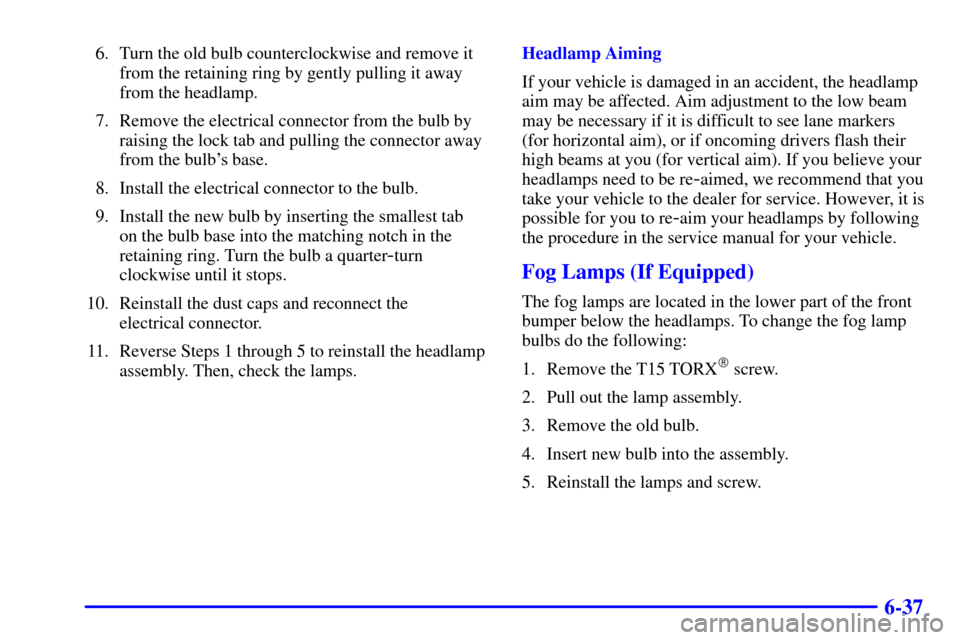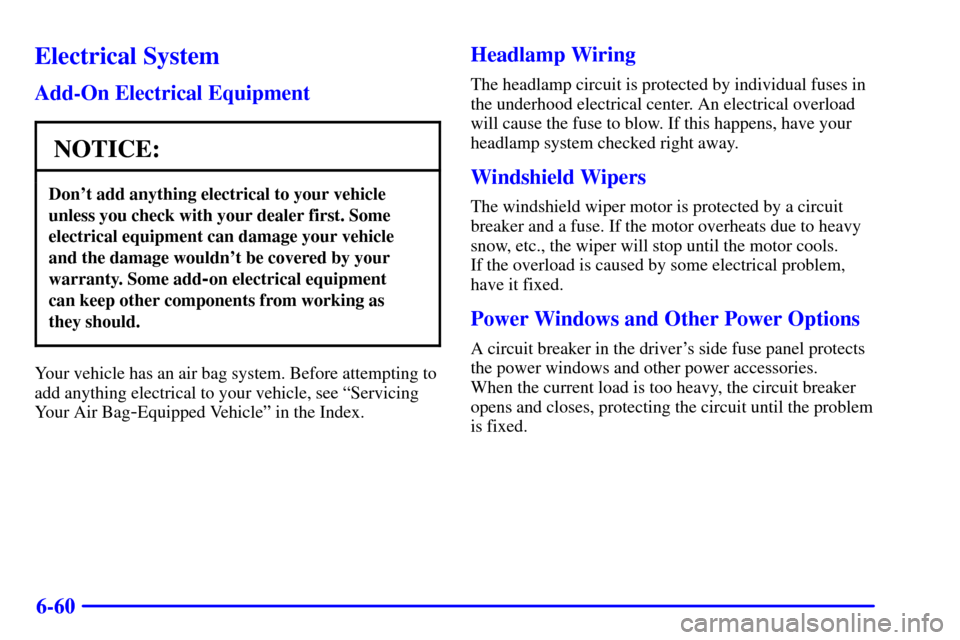Page 246 of 392

4-30
Run your engine only as long as you must. This saves
fuel. When you run the engine, make it go a little faster
than just idle. That is, push the accelerator slightly. This
uses less fuel for the heat that you get and it keeps the
battery charged. You will need a well
-charged battery to
restart the vehicle, and possibly for signaling later on
with your headlamps. Let the heater run for a while.
Then, shut the engine off and close the window almost
all the way to preserve the heat. Start the engine again
and repeat this only when you feel really uncomfortable
from the cold. But do it as little as possible. Preserve the
fuel as long as you can. To help keep warm, you can get
out of the vehicle and do some fairly vigorous exercises
every half hour or so until help comes.
Recreational Vehicle Towing
Your vehicle was not designed to be towed with all four
wheels on the ground. If your vehicle must be towed,
see ªTowing Your Vehicleº in the Index.
NOTICE:
Towing your vehicle with all four wheels on the
ground will damage drivetrain components.
Loading Your Vehicle
Two labels on your vehicle show how much weight it
may properly carry. The Tire
-Loading Information label
is on the inside of the trunk lid. The label tells you the
proper size, speed rating and recommended inflation
pressures for the tires on your vehicle. It also gives you
important information about the number of people that
can be in your vehicle and the total weight you can
carry. This weight is called the vehicle capacity weight
and includes the weight of all occupants, cargo and all
nonfactory
-installed options.
Page 322 of 392
6-35
Bulb Replacement
For the proper type of replacement bulb, see
ªReplacement Bulbsº in the Index. For any bulb
changing procedure not listed in this section, contact
the service department of your dealer.
Halogen Bulbs
CAUTION:
Halogen bulbs have pressurized gas inside
and can burst if you drop or scratch the bulb.
You or others could be injured. Be sure to read
and follow the instructions on the bulb package.
Headlamps, Front Parking and Turn
Signal Lamps
A. Parking/Turn Signal Lamp
B. Low
-Beam Headlamp
C. High
-Beam Headlamp
Page 323 of 392
6-36
To remove the assembly do the following:
1. Open the hood.
2. Remove the air baffle.
3. Remove the two headlamp fasteners by pulling up
on them.
4. Gently pull the headlamp assembly away from the
vehicle and remove the electrical connector.
5. Remove the round dust caps to gain access to
the bulbs.
Page 324 of 392

6-37
6. Turn the old bulb counterclockwise and remove it
from the retaining ring by gently pulling it away
from the headlamp.
7. Remove the electrical connector from the bulb by
raising the lock tab and pulling the connector away
from the bulb's base.
8. Install the electrical connector to the bulb.
9. Install the new bulb by inserting the smallest tab
on the bulb base into the matching notch in the
retaining ring. Turn the bulb a quarter
-turn
clockwise until it stops.
10. Reinstall the dust caps and reconnect the
electrical connector.
11. Reverse Steps 1 through 5 to reinstall the headlamp
assembly. Then, check the lamps.Headlamp Aiming
If your vehicle is damaged in an accident, the headlamp
aim may be affected. Aim adjustment to the low beam
may be necessary if it is difficult to see lane markers
(for horizontal aim), or if oncoming drivers flash their
high beams at you (for vertical aim). If you believe your
headlamps need to be re
-aimed, we recommend that you
take your vehicle to the dealer for service. However, it is
possible for you to re
-aim your headlamps by following
the procedure in the service manual for your vehicle.
Fog Lamps (If Equipped)
The fog lamps are located in the lower part of the front
bumper below the headlamps. To change the fog lamp
bulbs do the following:
1. Remove the T15 TORX
� screw.
2. Pull out the lamp assembly.
3. Remove the old bulb.
4. Insert new bulb into the assembly.
5. Reinstall the lamps and screw.
Page 337 of 392

6-50
NOTICE:
The wrong wheel can also cause problems with
bearing life, brake cooling, speedometer or
odometer calibration, headlamp aim, bumper
height, vehicle ground clearance and tire or tire
chain clearance to the body and chassis.
See ªChanging a Flat Tireº in the Index for
more information.
Used Replacement Wheels
CAUTION:
Putting a used wheel on your vehicle is
dangerous. You can't know how it's been used or
how far it's been driven. It could fail suddenly
and cause an accident. If you have to replace a
wheel, use a new GM original equipment wheel.
Tire Chains
NOTICE:
Use tire chains only where legal and only when
you must. Use only SAE Class ªSº type chains
that are the proper size for your tires. Install
them on the front tires and tighten them as
tightly as possible with the ends securely
fastened. Drive slowly and follow the chain
manufacturer's instructions. If you can hear the
chains contacting your vehicle, stop and retighten
them. If the contact continues, slow down until it
stops. Driving too fast or spinning the wheels
with chains on will damage your vehicle.
Page 347 of 392

6-60
Electrical System
Add-On Electrical Equipment
NOTICE:
Don't add anything electrical to your vehicle
unless you check with your dealer first. Some
electrical equipment can damage your vehicle
and the damage wouldn't be covered by your
warranty. Some add
-on electrical equipment
can keep other components from working as
they should.
Your vehicle has an air bag system. Before attempting to
add anything electrical to your vehicle, see ªServicing
Your Air Bag
-Equipped Vehicleº in the Index.
Headlamp Wiring
The headlamp circuit is protected by individual fuses in
the underhood electrical center. An electrical overload
will cause the fuse to blow. If this happens, have your
headlamp system checked right away.
Windshield Wipers
The windshield wiper motor is protected by a circuit
breaker and a fuse. If the motor overheats due to heavy
snow, etc., the wiper will stop until the motor cools.
If the overload is caused by some electrical problem,
have it fixed.
Power Windows and Other Power Options
A circuit breaker in the driver's side fuse panel protects
the power windows and other power accessories.
When the current load is too heavy, the circuit breaker
opens and closes, protecting the circuit until the problem
is fixed.
Page 348 of 392
6-61 Fuses and Circuit Breakers
The wiring circuits in your vehicle are protected from
short circuits by a combination of fuses, circuit
breakers and fusible thermal links in the wiring itself.
This greatly reduces the chance of fires caused by
electrical problems.
Look at the silver
-colored band inside the fuse. If the
band is broken or melted, replace the fuse. Be sure you
replace a bad fuse with a new one of the identical size
and rating.
Driver's Side Instrument Panel Fuse Block
Some fuses are in a fuse
block on the driver's side
of the instrument panel.
Pull off the cover labeled
FUSES to expose the fuses.
Circuit Relay Description
HEADLAMP
RELAYHeadlamp Relay
RETAINED
ACCESSORY
PWR RELAYRetained Accessory Power Relay
Page 352 of 392
6-65
Underhood Fuse Block (Upper)
Some fuses are in a fuse block on the passenger's side of the
engine compartment. See ªEngine Compartment Overviewº
in the Index for more information on location.
Circuit Relay Description
FUEL PUMP Fuel Pump
DRL RELAY Daytime Running Lamps
A.I.R. RELAY Air Induction Reaction Relay
CRANK RLY Starter (Crank) Relay
HORNS Horn
FOG LTS Fog LampsMaxi Fuses Description
LEFT I/P Left Bussed Electrical
Center (Battery)
RT I/P #1 Right Bussed Electrical
Center (Battery)
RT I/P #2 Right Bussed Electrical
Center (Battery)
U/HOOD #1 Underhood (Top) Electrical Center
Mini Fuses Description
HORN RLY Horn Relay
BLANK Blank
BLANK Blank
FOG RLY Fog Lamp Relay
F/PMP RLY Fuel Pump Relay
DRL/EXIT LTS Low (Left Front) & High
(Left Front) Headlamps
EXT LTS Low (Right Front) & High
(Right Front) Headlamps
PCM PCM Battery
A/C RLY
(CMPR)HVAC Compressor
Relay & Generator